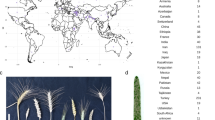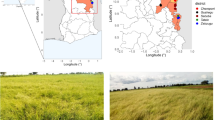Abstract
Main conclusion
This DNA fingerprinting test confirmed 195 unique Corylus sp. accessions that were used to build a reference database for identity verification of unknown hazelnut trees from three locations in Ontario.
Abstract
Hazelnut is one of the most profitable tree nuts worldwide. Development of a hazelnut industry in Ontario is urgently required, but economically important cultivars must be genetically verified first in order to meet industry standards. Traditional methods for cultivar identification are largely trait-based and unreliable. In this study, a multiplexed fingerprinting test was modified to allow for hazelnut cultivar discrimination at the DNA level. Fourteen highly polymorphic SSR markers covering the 11 linkage groups of Corylus genome were PCR amplified in multiplex using fluorescent-labelled primers. PCR conditions and primer physical properties were optimized to generate a clear signal for each locus. The 14 SSRs were used to fingerprint 195 unique Corylus accessions collected from the USDA-NCGR. Fragment sizes were subjected to a UPGMA clustering analysis which separated Corylus accessions based on species and geographic origin. For validation purposes, hazelnut leaves from three locations in Ontario were collected for identity verification using this DNA fingerprinting test. As a result, 33.3% of the unknown trees were duplicates of seven distinct genotypes and a small percentage (8.3%) of these were identical to reference Corylus hybrids. These results reflect common mislabelling issues and genotype duplications that can prevent a uniform plant propagation system. Implementation of this test together with the addition of more unique accessions to the reference database will help verification of trueness-to-type of economically important cultivars for the hazelnut industry.

Similar content being viewed by others
Abbreviations
- EFB:
-
Eastern filbert blight
- PIC:
-
Polymorphism information content
- SSR:
-
Simple sequence repeat
- UPGMA:
-
Unweighted pair group method with arithmetic mean
References
Akin M, Nyberg A, Postman J, Mehlenbacher S, Bassil NV (2016) A multiplexed microsatellite fingerprinting set for hazelnut cultivar identification. Eur J Hortic Sci 81(6):327–338
Bassil NV, Azarenko AN (2001) Random amplified polymorphic DNA (RAPD) markers for self-incompatibility in Corylus avellana. Acta Hort 556:537–543
Bassil NV, Botta R, Mehlenbacher SA (2005) Microsatellite markers in hazelnut: isolation, characterization, and cross-species amplification. J Am Soc Hortic Sci 130(4):543–549
Bassil N, Boccacci P, Botta R, Postman J, Mehlenbacher S (2013) Nuclear and chloroplast microsatellite markers to assess genetic diversity and evolution in hazelnut species, hybrids and cultivars. Genet Resour Crop Evol 60(2):543–568
Bhattarai G (2015) Microsatellite marker development, characterization and mapping in European hazelnut (Corylus avellana L.), and investigation of novel sources of eastern filbert blight resistance in Corylus. Dissertation, Oregon State University
Boccacci P, Botta R (2009) Investigating the origin of hazelnut (Corylus avellana L.) cultivars using chloroplast microsatellites. Genet Resour Crop Evol 56(6):851–859
Boccacci P, Botta R (2010) Microsatellite variability and genetic structure in hazelnut (Corylus avellana L.) cultivars from different growing regions. Sci Hort 124:128–133
Boccacci P, Akkak A, Botta R (2006) DNA typing and genetic relations among European hazelnut (Corylus avellana L.) cultivars using microsatellite markers. Genome 49(6):598–611
Boccacci P, Botta R, Rovira M (2008) Genetic diversity of hazelnut (Corylus avellana L.) germplasm in northeastern Spain. HortScience 43(3):667–672
Boccacci P, Aramini M, Valentini N, Bacchetta L, Rovira M, Drogoudi P, Silva AP, Solar A, Calizzano F, Erdoğan V, Cristofori V (2013) Molecular and morphological diversity of on-farm hazelnut (Corylus avellana L.) landraces from southern Europe and their role in the origin and diffusion of cultivated germplasm. Tree Genet Genomes 9(6):1465–1480
Brownstein MJ, Carpten JD, Smith JR (1996) Modulation of non-templated nucleotide addition by Taq DNA polymerase: primer modifications that facilitate genotyping. Biotechniques 20(6):1004–1010
Cameron HR (1976) Eastern filbert blight established in the Pacific Northwest. Plant Dis Rep 60:737–740
Capik JM, Molnar TJ (2014) Flowering phenology of eastern filbert blight-resistant hazelnut accessions in New Jersey. HortTechnol 24(2):196–208
Chapuis MP, Estoup A (2006) Microsatellite null alleles and estimation of population differentiation. Mol Biol Evol 24(3):621–631
Coyne CJ, Mehlenbacher SA, Smith DC (1998) Sources of resistance to eastern filbert blight in hazelnut. J Am Soc Hortic Sci 123(2):253–257
Dale A, Galic D, Leuty T, Filotas M, Currie E (2012) Hazelnuts in Ontario—biology and potential varieties. OMAFRA FactSheet. http://www.omafra.gov.on.ca/english/crops/facts/12-007.htm. Accessed 13 Sep 2018
Davison AD, Davidson RM (1973) Apioporthe and Monochaetia cankers reported in western Washington. Plant Dis Rep 57:522–523
Erdogan V (1999) Genetic relationships among hazelnut (Corylus) species. Dissertation, Oregon State University
Erdogan V, Mehlenbacher SA (2000a) Interspecific hybridization in hazelnut (Corylus). J Am Soc Hortic Sci 125(4):489–497
Erdogan V, Mehlenbacher SA (2000b) Phylogenetic relationships of Corylus species (Betulaceae) based on nuclear ribosomal DNA ITS region and chloroplast matK gene sequences. Syst Bot 25(4):727–737
FAOSTAT database (2013) Food and Agriculture Organization of the United Nations, Statistics Division. http://fenix.fao.org/faostat/beta/en/#home. Accessed 22 Nov 2018
Ferrari M, Gori M, Monnanni R, Biuatti M, Scarascia Mugnozza GT, De Pace C (2004) DNA fingerprinting of Corylus avellana L. accessions revealed by AFLP molecular markers. Acta Hort 686:125–134
Gökirmak T, Mehlenbacher SA, Bassil NV (2009) Characterization of European hazelnut (Corylus avellana) cultivars using SSR markers. Genet Resour Crop Evol 56(2):147–172
Gottwald TR, Cameron HR (1979) Studies in the morphology and life history of Anisogramma anomala. Mycologia 71(6):1107–1126
Gürcan K, Mehlenbacher SA, Erdoğan V (2010) Genetic diversity in hazelnut (Corylus avellana L.) cultivars from Black Sea countries assessed using SSR markers. Plant Breed 129(4):422–434
Huang K, Ritland K, Dunn DW, Qi X, Guo S, Li B (2016) Estimating relatedness in the presence of null alleles. Genetics 202(1):247–260
Jaceldo-Siegl K, Haddad E, Oda K, Fraser GE, Sabaté J (2014) Tree nuts are inversely associated with metabolic syndrome and obesity: the Adventist health study-2. PLoS One 9(1):e85133
Julian J, Seavert C, Olsen JL (2009) An economic evaluation of the impact of eastern filbert blight resistant cultivars in Oregon, USA. Acta Hort 845:725–732
Kalinowski ST, Taper ML, Marshall TC (2007) Revising how the computer program CERVUS accommodates genotyping error increases success in paternity assignment. Mol Ecol 16(5):1099–1106
Korir NK, Han J, Shangguan L, Wang C, Kayesh E, Zhang Y, Fang J (2013) Plant variety and cultivar identification: advances and prospects. Crit Rev Biotechnol 33(2):111–125
Lagerstedt HB (1975) Filberts. In: Janick J, Moore JN (eds) Advances in fruit breeding. Purdue University Press, West Lafayette, pp 456–489
Leuty T, Galic D, Bailey P, Dale A, Currie E, Filotas M (2012) Hazelnuts in Ontario—growing, harvesting and food safety. OMAFRA FactSheet. http://www.omafra.gov.on.ca/english/crops/facts/12-011.htm. Accessed 25 Oct 2018
Lunde CF, Mehlenbacher SA, Smith DC (2000) Survey of hazelnut cultivars for response to eastern filbert blight inoculation. HortScience 35(4):729–731
Markoulatos P, Siafakas N, Moncany M (2002) Multiplex polymerase chain reaction: a practical approach. J Clin Lab Anal 16:47–51
Marshall TC, Slate JBKE, Kruuk LEB, Pemberton JM (1998) Statistical confidence for likelihood-based paternity inference in natural populations. Mol Ecol 7(5):639–655
Mehlenbacher SA, Thompson MM, Cameron HR (1991) Occurrence and inheritance of resistance to eastern filbert blight in ‘Gasaway’ hazelnut. HortScience 26(4):410–411
Mehlenbacher SA, Smith DC, McCluskey RL, Thompson MM (2011) ‘Tonda Pacifica’ hazelnut. HortScience 46(3):505–508
Molnar TJ (2011) Corylus. In: Kole C (ed) Wild crop relatives: Genomic and breeding resources, forest trees. Springer, Berlin, pp 15–48
Molnar TJ, Goffreda JC, Funk CR (2005) Developing hazelnuts for the Eastern United States. Acta Hort 686:609–618
Nei M (1972) Genetic distance between populations. Am Nat 106:283–292
Nei M (1978) Estimation of average heterozygosity and genetic distance from a small number of individuals. Genetics 89:583–590
Peakall ROD, Smouse PE (2006) GENALEX 6: genetic analysis in Excel. Population genetic software for teaching and research. Mol Ecol Notes 6(1):288–295
Peakall R, Smouse PE (2012) GenAlEx 6.5: genetic analysis in Excel. Population genetic software for teaching and research—an update. Bioinformatics 28(19):2537–2539
Peterschmidt B (2013) DNA markers and characterization of novel sources of eastern filbert blight resistance in European hazelnut (Corylus avellana L.). Dissertation, Oregon State University
Pomper KW, Azarenko AN, Bassil N, Davis JW, Mehlenbacher SA (1998) Identification of random amplified polymorphic DNA (RAPD) markers for self-incompatibility alleles in Corylus avellana L. Theor Appl Genet 97:479–487
Powell W, Morgante M, Andre C, Hanafey M, Vogel J, Tingey S, Rafalski A (1996) The comparison of RFLP, RAPD, AFLP and SSR (microsatellite) markers for germplasm analysis. Mol Breed 2(3):225–238
R Core Team (2013) R: a language and environment for statistical computing. R Foundation for Statistical Computing. http://www.Rproject.org/. Accessed 28 Sep 2018
Sathuvalli VR, Mehlenbacher SA (2013) De novo sequencing of hazelnut bacterial artificial chromosomes (BACs) using multiplex Illumina sequencing and targeted marker development for eastern filbert blight resistance. Tree Genet Genom 9:1109–1118
Sathuvalli VR, Mehlenbacher SA, Smith DC (2012) Identification and mapping of DNA markers linked to eastern filbert blight resistance from OSU 408.040 hazelnut. HortScience 47(5):570–573
Solar A, Stampar F (2011) Characterisation of selected hazelnut cultivars: phenology, growing and yielding capacity, market quality and nutraceutical value. J Sci Food Agric 91(7):1205–1212
Tekin E (2016) The politics of market relations in a nutshell. PGDT 15(4):419–448
Thompson MM, Romisondo P, Germain E, Vidal-Barraquer R, Valls JT (1978) An evaluation system for filberts (Corylus avellana L.). HortScience 13:514–517
Thompson MM, Lagerstedt HB, Mehlenbacher SA (1996) Hazelnuts. In: Janick J, Moore N (eds) Fruit breeding, vol III. N uts. Wiley, New York, pp 125–184
Tulum O (2008) Political economy, productivity and profitability of Turkish hazelnut production. Dissertation, University of Massachusetts Lowell
Venkatachalam M, Sathe SK (2006) Chemical composition of selected edible nut seeds. J Agric Food Chem 54(13):4705–4714
Waples RS (2014) Testing for Hardy-Weinberg proportions: have we lost the plot? J Hered 106(1):1–19
Weissensteiner T, Lanchbury JS (1996) Strategy for controlling preferential amplification and avoiding false negatives in PCR typing. Biotechniques 21(6):1102–1109
Whitcher IN, Wen J (2001) Phylogeny and biogeography of Corylus (Betulaceae): inferences from ITS sequences. Syst Bot 26(2):283–298
Yang Z, Zhao T, Ma Q, Liang L, Wang G (2018) Comparative genomics and phylogenetic analysis revealed the chloroplast genome variation and interspecific relationships of Corylus (Betulaceae) species. Front Plant Sci 9:927
Zohary D, Hopf M, Weiss E (2012) Domestication of plants in the old world, 4th edn. Oxford University Press, Oxford, p 151
Acknowledgements
We thank Dr. Murali Mohan Ayyanath (GRIPP, University of Guelph) for assistance with hazelnut tree sampling at the local farms. We also thank Linda Grimo and Martin Hodgson for allowing us to fingerprint hazelnut trees from their nursery and farm, respectively. We are grateful to Dr. Shawn Mehlenbacher (Oregon State University) and April Nyberg (NCGR-USDA) for providing support with the multiplex PCR technique and germplasm collection. Technical assistance with sample preparation and operation of the ABI 3500 Genetic Analyzer from Christopher Grainger at the Plant Genomics Laboratory (Department of Plant Agriculture, University of Guelph) is gratefully acknowledged.
Funding
This study was funded by Ontario Center of Excellence and Ferrero Canada.
Author information
Authors and Affiliations
Corresponding author
Ethics declarations
Conflict of interest
The authors declare that they have no conflict of interest.
Additional information
Publisher's Note
Springer Nature remains neutral with regard to jurisdictional claims in published maps and institutional affiliations.
Electronic supplementary material
Below is the link to the electronic supplementary material.
Rights and permissions
About this article
Cite this article
Freixas-Coutin, J.A., An, S., Postman, J. et al. Development of a reliable Corylus sp. reference database through the implementation of a DNA fingerprinting test. Planta 249, 1863–1874 (2019). https://doi.org/10.1007/s00425-019-03131-4
Received:
Accepted:
Published:
Issue Date:
DOI: https://doi.org/10.1007/s00425-019-03131-4




